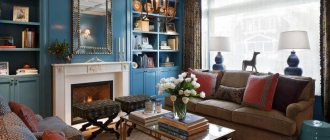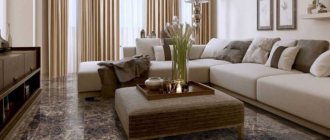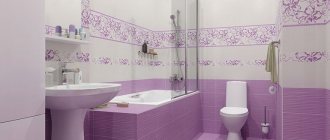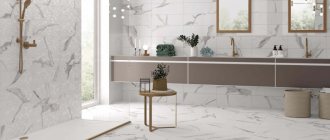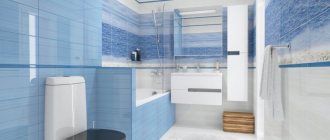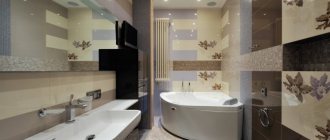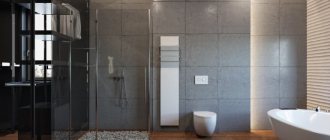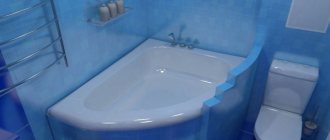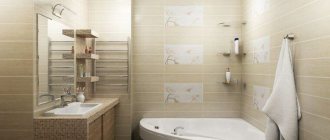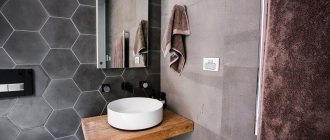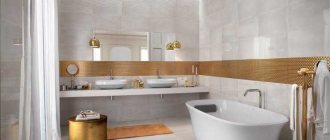The gray interior of the bathroom will not look boring or monotonous if you choose the right design option. After all, this color may seem dull and inexpressive only at first glance.
Depending on what shade of gray was chosen as the main tone and what additional colors were used besides it, such a bathroom will look completely different: strict and stylish, gentle and airy, elegant and sophisticated. And only incorrectly placed color accents or their complete absence can make the interior of a gray bathroom lifeless or dull.
Pros and cons of gray in bathroom design
Pros:
- This color is neutral and represents peace and stability.
- Gray shades are perceived well by most people.
- Does not cause psychological rejection or rejection.
- Shades of gray include many different shades: from very light, almost white to almost black, using which you can achieve various effects in the design of rooms.
- Goes great with almost any other color.
- Suitable for both ultra-modern and classic design styles.
- Light shades of this color visually expand the space, while dark shades narrow it. For this reason, gray is suitable for both spacious and small bathrooms.
IMPORTANT!
It should be noted that soft pearl gray tones are ideal for decorating bathrooms: they evoke a feeling of security and calm, which helps to achieve better relaxation during water procedures.
Minuses:
- Excess gray color in the interior can make the room boring and monotonous. However, adding bright accents helps to completely solve this problem.
- It is advisable to avoid the predominance of dark gray tones in the bathroom interior, since in large quantities they can have a depressing effect on the psyche, suppressing joyful emotions and even causing depression in people prone to melancholy.
- Dark shades of this color are not suitable for decorating small rooms, as they visually narrow the space, making such bathrooms look even smaller.
- Since gradations of light and shadow on surfaces of various textures make the interior stylish and cozy and help avoid monotony, such a bathroom needs good natural and artificial lighting. A good solution in this case would be additional lighting of individual areas in the bathroom with spotlights.
Advantages and disadvantages of gray tiles
The gray color palette is associated with serenity and peace. It is suitable for rooms that are intended for relaxation. Gray tiles have a number of advantages:
- Combines with rich flowers.
- Suitable for different styles.
- Dust and stains from cleaning products are least noticeable on gray.
- Practical shades for bathrooms.
Gray has few disadvantages, mainly:
- Using a lot of gray will make the design look monochrome.
- In small rooms, dark gray colors visually narrow the space.
Shades of gray
Gray color, having a strong reflective ability, when used correctly in interior design, can visually change the space: expand or, conversely, visually narrow it.
Depending on the depth of tone, it has different effects on the psyche and nervous system of people and this must be taken into account when developing the design of a gray bathroom.
- Silver gray.
This beautiful tone, associated with calm and comfort, visually expands the boundaries of the room. It will be especially good when decorating small bathrooms. - Classic gray and mouse shades.
They require a contrasting environment, without which they can look boring and monotonous. In combination with other colors they transform and look noble and truly stylish. - Light gray and pearl.
These shades in the bathroom interior create a light and even cheerful impression. Due to their proximity to white, they have the ability to visually expand the space, which makes them indispensable when decorating small bathrooms. When combined with darker shades of gray, these tones become especially expressive and even visually glow from within. - Dark grey.
The color of stability and self-confidence, it is ideal for people who set high goals and strive for them. This shade does not look very good as a main color for a bathroom, as it may have a depressing effect on some people. However, dark gray color can be used when decorating a bathroom interior, but only in the form of accents, for example, allocating space above the sink or near the bathtub. - Gray-blue.
The color of the pigeon's wing, as it is also called, will give the bathroom a sophisticated and noble look. This coolish tone is ideal for decorating a room in a classic style, although it will also look good in modern interiors. However, you need to take into account that it, like other darkish shades, visually narrows the space, and therefore is not very suitable as the main wall tone for small bathrooms.
IMPORTANT!
Dark tones of gray suggest stability and certainty, while light shades create the impression of uncertainty and visually blur the space.
Finishes and materials
Light gray tiles with different additions in the base are suitable for walls: drawings, gradient, print. To expand the space of the bathroom, it is worth using light shades in floor tiles.
The floor should be laid with tiles special for flooring, and the surface should be level before starting work.
Most often, in repairs, preference is given to stretch ceilings. But for greater safety, it is worth decorating the ceilings using plastic plates.
Light shades in the design of the ceiling look better, such as cream, white, ivory.
What colors does it go with?
Gray in bathroom interiors is most often combined with the following colors:
Black.
This combination, considered classic French chic, since it is in France that it is most often used in interior design, does not look boring or uninteresting. Black successfully sets off gray tones and gives them a touch of exquisite luxury and perfection.
White.
A win-win classic combination that brings calm, serenity and lightness to the interior. But with this option for decorating a bathroom, it is very important to maintain white balance: its excess will visually turn the bathroom into a semblance of a hospital room.
Red.
Placed indoors in the form of small bright accents, red will dilute the monotony of grayish shades and add liveliness and originality to the interior.
Blue and light blue.
Despite the fact that these colors go well with gray, this combination is considered only conditionally suitable for decorating bathrooms. Blue and blue tones will further emphasize the psychological coldness of gray and make the room poor in terms of emotionality and not conducive to calm relaxation.
As a last resort, a combination of very light, pearl-gray tones with rich azure is allowed. It is also possible to use light blue with dark gray, but as small accents, for example, as a pattern on tiles.
Yellow.
A grayish-yellow bathroom can look a bit dirty if variations of the two original colors that are similar in lightness are used. However, a combination of pearl or graphite with rich canary can be advantageous due to the fact that gray shades slightly restrain the brightness of yellow, without completely drowning it out, and at the same time visually acquire a refined and noble depth of tone.
Orange.
Bright and rich shades of orange or carrot can be an unexpectedly successful complement to gray when decorating bathrooms. In combination with it, they not only do not lose their fiery brightness, but, as it were, begin to glow from within. Orange tones combine perfectly with any grayish shades, giving the interior liveliness and sunny warmth.
Green.
Not all green tones in combination with gray look good. They pair best with pearl or other pale shades of the base color. However, for example, a combination of graphite with the color of green apple or lime may turn out to be successful.
Brown.
Brown tones of natural wood are especially good in combination with grayish stone or marble. They will bring a touch of refined simplicity to the room and will be the perfect complement to the design of minimalist bathrooms.
Peculiarities
Real wood tiles are not used on bathroom walls because wood (no matter how it is treated) absorbs moisture and deteriorates. Therefore, a replacement was invented - wood-look ceramic tiles. Today, shades and textures are created in such a way that it can be difficult to distinguish real wood from other materials.
But wood can be used in the bath as furniture. Choose wooden shelves and cabinets coated with several layers of thin yacht varnish so that moisture does not corrode the material. With careful handling and proper care, such furniture can last for many years in the bathroom.
Let's return to the tiles. Wood-effect tiles in the bathroom are used for both walls and floors. There are quite a lot of shades of it today - from gray oak to alder or walnut. This coating can be used both in a small room and in large rooms where there is a shower stall and a regular bathtub.
Decorating a bathroom with wood-effect tiles requires care and attention - the pattern must match on each tile and form the correct pattern. Usually, each set of ceramics with a pattern comes with instructions that tell you how best to lay a particular coating. So professionals should not have any problems with repairs.
The tiles are laid in several ways, but regardless of the choice, you should adhere to the general rules:
- you need to start laying the tiles from the far corner and move towards the door;
- before installation, all walls and floors must be treated with an antiseptic and primer;
- In order for the floor to be level after installation, it should be leveled before the cladding;
- tile adhesive is applied to the back side of the tile, the excess is removed;
- if standard laying technology with seams is used, then the seams are subsequently rubbed with a special moisture-resistant compound;
- the seamless installation method is not used for all types of ceramics and porcelain stoneware;
- The “grout” can match the tile or any other color; white is usually used.
Choosing furniture for a gray bathroom
Mirror and glass matte surfaces will look especially good in this bathroom interior.
The color of the furniture can be any of the shades that combine well with gray, but it should be noted that furniture made from natural materials is more suitable for classic interiors than, for example, plastic or assembled from metal structures.
Cabinets, shelves and other furnishings should be consistent in style with the overall design. Dark wood cabinets on curved legs with carvings and inlays are suitable for rooms in classical styles. For modern trends, the best choice would be simple-shaped plastic pieces of furniture and plumbing fixtures.
It should also be taken into account that the furniture should look contrasting against the background of the surrounding walls. If the bathroom is decorated in a light grayish color scheme, then it is better to give preference to dark cabinets or shelves. And for dark gray walls, the ideal complement would be furniture in light or bright and contrasting rich shades. Fittings and metal parts of plumbing fixtures are preferably silver or chrome plated. Golden and bronze tones are also acceptable when decorating such bathrooms, but only with certain color combinations in the interior: with gray of a different shade, with black, with orange and with brown tones. In all other cases, gilded decor on furniture in such bathrooms is best avoided.
IMPORTANT!
Plumbing fixtures of a lighter shade look most appropriate in bathrooms decorated in grayish tones.
And if light gray or pearl shades are used as the main color in the interior, then dazzling white plumbing fixtures would be a good choice.
Accessories
To diversify the neutral monotony of gray tones, in such bathrooms it is recommended to use bright and richly colored towels, bathrobes, rugs, soap dishes and other accessories as decor.
At the same time, the interior looks best if it is designed in two primary colors. Gray is used as the main tone for decorating the room, and additional gray is used as bright accents.
IMPORTANT!
Too many accessories of different styles and colors will make the bathroom too colorful and deprive it of refined restraint and style.
Wood-effect tiles on the bathroom floor
Due to the relief texture and various sizes, wooden porcelain tiles can almost exactly imitate natural parquet. And the problem with non-wood cold can be easily solved by installing a floor heating system or a simple soft rug under your feet.
Like parquet, porcelain tiles on the floor can be laid in different ways - herringbone, checkers, deck, wicker and labyrinth. For a small room, it is better to choose medium-sized fragments - large stripes will look disproportionately large, and too small ones will visually fragment the space.
Instagram @khandesign.ru
Instagram @yanasdecor
Instagram @alexey_volkov_ab
Instagram @khandesign.ru
- Bathroom, toilet
7 designer bathrooms that meet modern trends
